肝脏体积变化的判断
- 格式:doc
- 大小:23.50 KB
- 文档页数:1
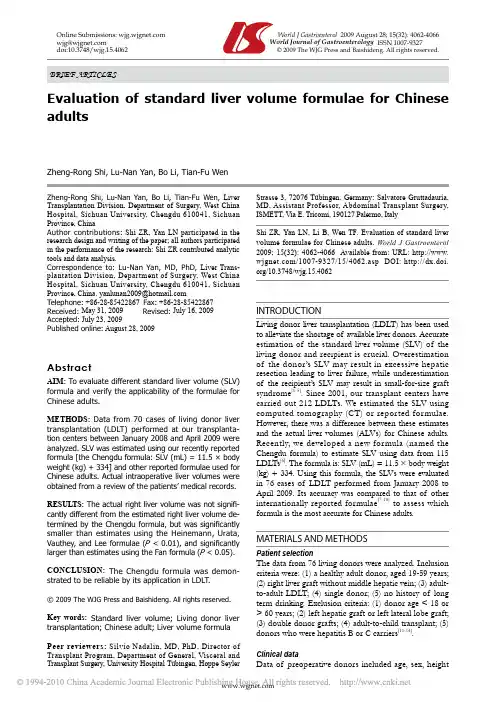
Zheng-Rong Shi, Lu-Nan Yan, Bo Li, Tian-Fu Wen, Liver Transplantation Division, Department of Surgery, West China Hospital, Sichuan University, Chengdu 610041, Sichuan Province, ChinaAuthor contributions: Shi ZR, Yan LN participated in the research design and writing of the paper; all authors participated in the performance of the research; Shi ZR contributed analytic tools and data analysis.Correspondence to: Lu-Nan Yan, MD, PhD, Liver Trans-plantation Division, Department of Surgery, West China Hospital, Sichuan University, Chengdu 610041, Sichuan Province, China. yanlunan2009@ Telephone: +86-28-85422867 Fax: +86-28-85422867 Received: May 31, 2009Revised: July 16, 2009 Accepted: July 23, 2009Published online: August 28, 2009AbstractAIM: To evaluate different standard liver volume (SLV) formula and verify the applicability of the formulae for Chinese adults.METHODS:Data from 70 cases of living donor liver transplantation (LDLT) performed at our transplanta-tion centers between January 2008 and April 2009 were analyzed. SLV was estimated using our recently reported formula [the Chengdu formula: SLV (mL) = 11.5 × body weight (kg) + 334] and other reported formulae used for Chinese adults. Actual intraoperative liver volumes were obtained from a review of the patients’ medical records. RESULTS:The actual right liver volume was not signifi -cantly different from the estimated right liver volume de-termined by the Chengdu formula, but was signifi cantly smaller than estimates using the Heinemann, Urata, Vauthey, and Lee formulae (P < 0.01), and signifi cantly larger than estimates using the Fan formula (P < 0.05). CONCLUSION: The Chengdu formula was demon-strated to be reliable by its application in LDLT.© 2009 The WJG Press and Baishideng. All rights reserved.Key words: Standard liver volume; Living donor liver transplantation; Chinese adult; Liver volume formulaPeer reviewers: Silvio Nadalin, MD, PhD, Director of Transplant Program, Department of General, Visceral and Transplant Surgery, University Hospital Tübingen, Hoppe Seyler Strasse 3, 72076 Tübingen, Germany; Salvatore Gruttadauria, MD, Assistant Professor, Abdominal Transplant Surgery, ISMETT, Via E. Tricomi, 190127 Palermo, ItalyShi ZR, Yan LN, Li B, Wen TF. Evaluation of standard liver volume formulae for Chinese adults. World J Gastroenterol 2009; 15(32): 4062-4066 Available from: URL: http://www. /1007-9327/15/4062.asp DOI: http://dx.doi. org/10.3748/wjg.15.4062INTRODUCTIONLiving donor liver transplantation (LDLT) has been used to alleviate the shortage of available liver donors. Accurate estimation of the standard liver volume (SLV) of the living donor and recipient is crucial. Overestimation of the donor’s SLV may result in excessive hepatic resection leading to liver failure, while underestimation of the recipient’s SLV may result in small-for-size graft syndrome[1-5]. Since 2001, our transplant centers have carried out 212 LDLTs. We estimated the SLV using computed tomography (CT) or reported formulae. However, there was a difference between these estimates and the actual liver volumes (ALVs) for Chinese adults. Recently, we developed a new formula (named the Chengdu formula) to estimate SLV using data from 115 LDLTs[6]. The formula is: SLV (mL) = 11.5 × body weight (kg) + 334. Using this formula, the SLVs were evaluated in 76 cases of LDLT performed from January 2008 to April 2009. Its accuracy was compared to that of other internationally reported formulae[7-10] to assess which formula is the most accurate for Chinese adults. MATERIALS AND METHODSPatient selectionThe data from 76 living donors were analyzed. Inclusion criteria were: (1) a healthy adult donor, aged 19-59 years;(2) right liver graft without middle hepatic vein; (3) adult-to-adult LDLT; (4) single donor; (5) no history of long term drinking. Exclusion criteria: (1) donor age < 18 or > 60 years; (2) left hepatic graft or left lateral lobe graft;(3) double donor grafts; (4) adult-to-child transplant; (5) donors who were hepatitis B or C carriers[11-14].Clinical dataData of preoperative donors included age, sex, heightOnline Submissions: World J Gastroenterol 2009 August 28; 15(32): 4062-4066 wjg@ World Journal of Gastroenterology ISSN 1007-9327doi:10.3748/wjg.15.4062 © 2009 The WJG Press and Baishideng. All rights reserved.Evaluation of standard liver volume formulae for Chinese adultsZheng-Rong Shi, Lu-Nan Yan, Bo Li, Tian-Fu WenBRIEF ARTICLES(BH, measured to the nearest 1 cm), body weight (BW , measured to the nearest 0.5 kg), and body surface area (BSA) calculated using the DuBois formula: BSA (m 2) = BW (kg) 0.425 × BH (cm) 0.725 × 0.007184 or the Mosteller formula: BSA (m 2) = square root BH (cm) × BW (kg)/3600. From the diaphragm to the superior mesenteric artery plane, the entire liver image was scanned using a 7 mm thick layer. In the Leonardo workstation, the LV was measured by venous phase images [15,16]. All preoperative CT examinations of donors were performed by a single radiologist and all donor procedures were performed by the same surgical unit. The volume of the grafts was measured by a 3 L beaker using a drainage method intraoperatively and the error was less than 10 mL [17,18].Right liver graft without middle hepatic vein reconstruction from a living donor was performed as described, with temporary occlusion of the right portal vein (PV) and right hepatic artery and use of ultrasonography to guide parenchymal transection. The right hepatic duct, right hepatic artery, right portal vein branch, and right hepatic vein were transected approximately 2-3 mm from the con fl uence [19,20], leaving the donor’s main PV and confluence intact. The graft was flushed with University of Wisconsin solution through the PV and hepatic artery [21,22].The volume of 70 livers was calculated using the Chengdu standard LV formula [6] as described above. The estimated right LV (ERLV) was obtained by multiplying the SLV by the proportion of the LV contributed by the right lobe on CT. The actual right LV (ARLV) was obtained by intraoperative measurement. The differencebetween the ERLV and ARLV was statistically evaluated. The formulae of Heinemann et al [8], Urata et al [7], Vauthey et al [9], Lee et al [5], and Fan et al [4] in addition to our own formula [6] were used to determine the estimated SLV (ESLV) of our donor livers. The previously reported formulae are shown in Table 1. For each liver, we calculated the difference between the ALV and volume estimated by each formula (ELV).Statistical analysisAfter testing for normal distribution (kurtosis and skewness tests), descriptive statistics were calculated and data were expressed as means ± SD for age (year), BW (kg), BH (cm), body mass index (BMI), and BSA. The ERLV-ARLV and the ELV-ALV were compared by the 2-sided paired-samples t -test. P < 0.05 was considered statistically significant. All statistical analyses were performed using the SPSS (version 13.0) program.RESULTSSeventy donors (all Chinese; 53 men and 17 women; mean age, 32.21 ± 10.07; range, 19-57 years) met the selection criteria. All donors were related to the recipients.The characteristics of donors are shown in Table 2. All donors were considered healthy on the basis of BMI. All but one donor with a BMI of 17 kg/m 2 had a BMI of 18-28 kg/m 2. The mean volume of the right lobe on CT was 658.98 ± 81.14 mL and represented 55.4% ± 3.7% of the whole liver on CT.The mean ELV and mean ERLV using the Chengdu standard formula were 1058.70 ± 96.74 mL and 586.15 ± 67.17 mL, respectively. The mean ARLV was 578.58 ± 72.33 mL. Differences for individual donors between ERLV and ARLV were not signi fi cant (t = -1.882, P = 0.064). A plot of the relationship of ARLV to the ERLV calculated using the Chengdu formula is shown in Figure 1. The mean total LV determined preoperatively on CT was 1189.53 ± 114.75 mL. The mean RLV on CT without the middle hepatic vein was 658.98 ± 81.14 mL, and 55.4% ± 3.7% of the total LV . The ALV calculated from the volume of the graft and the ratio of the RLV to the total LV on CT (%) was 1050.10 ± 107.41 mL. The Heinemann, Urata, Vauthey, and Lee formulae signi fi cantly overestimated the LV (P < 0.01), while the Fan formula significantly underestimated the LV (P <Shi ZR et al . Liver volume formulae for Chinese adults 4063ESLV: Estimated standard liver volume; BSA: Body surface area; BW: Body weight; CT: Computed tomography; LDLT: Living donor liver transplantation.Table 2 Donor characteristicsMHV: Middle hepatic vein.0.05). There was no signi fi cant difference between ALV and ELV using the Chengdu formula (Figure 2).DISCUSSIONCT has become a standard method for assessing livergraft volume in living donors. Estimation of LV by CT (compared to actual volume) has a margin of error of 5%-25%[23,24]. In the present study, all donors had preoperative CT assessment of LV (mean total LV , 1189.53 ± 114.75 mL and mean volume of right lobe graft without middle hepatic vein, 658.98 ± 81.14 mL). The actual volume of the right liver was 578.58 ± 72.33 mL. In the present study, the LV on CT was 10%-20% higher than the ALV [25-27]. The reasons may be as follows: (1) Preoperative CT measurement is carried out under normal blood fl ow conditions. Perioperatively, liver resection interrupts the blood supply causing a loss of liquid volume, collapse of supporting structures, and thereby reduction in the volumeof the liver. (2) Sources of error (partial volume effect, inter-observer variation, and respiratory movements) may account for this difference [28].The difference between the ERLV (using our formula) and ARLV was compared to the difference between ERLV, calculated using the formulae of Heinemann, Urata, Vauthey, Lee, and Fan, and ARLV in our 70 donors. The Heinemann, Urata, Vauthey, and Lee formulae overestimated LV (P < 0.01)[29]. The reasons may include: ethnic differences (patients in Europe and the United States were Caucasian). All except the Sheung Tat Fan and Chengdu formulae were used to estimate LV from CT LV or autopsy LV. Estimates of LV by CT were 5%-25% higher than the ALV [30].Statistical analysis showed that the Fan formula tends to underestimate LV. The weight and height of the donors in our study were higher than of those in the Hong Kong group. This may be one of the reasons both results are very close (Table 3). Above all, we believe thatALV: Actual liver volume; ND: Not determined.Figure 1 Correlation between actual right liver volume (ARLV) and estimated right liver volume (ERLV) by the Chengdu formula. When both were the same, a dot would be on the linear line.500 600 700Graft ARLV700600500E R L VFigure 2 Correlation between actual liver volume (ALV) and estimated liver volume (ELV) by each formula. When both were the same, a dot would be on the linear line. Formulae of Urata, Heinemann, Vauthey, and Lee overestimated LV with respect to ALV. The Fan formula underestimated LV and the Chengdu formula gave a good estimate of ALV.4064 ISSN 1007-9327 CN 14-1219/R World J Gastroenterol August 28, 2009 Volume 15 Number 32700 900 1100 1300 1500ALV150013001100900700U r a t a700 1000 13001600ALV160013001000700H e i n e m a n n700 900 1100 1300 1500ALV150013001100900700L e e700 1000 1300 1600ALV160013001000700V a u t h e y700 900 1100 1300 1500ALV150013001100900700F a n700 800 900 1000 1100 1200 1300ALV14001300120011001000900800700C h e n g d uthe Chengdu formula was demonstrated to be reliable by its application in LDLT. We were limited to use of single center data in the present study, but we hope to improve the formula by using national multicenter data in the future[31].With development of living donor liver transplantation (LDLT), especially improvement of right graft adult-to-adult LDLT, the danger of donating has been paid more and more attention. The exact liver volume is not only relevant for the recipient, but also for the donor to avoid dangerous life-threatening residual liver volumes.Research frontiersScholars of different countries established several standard liver volume (SLV) formulae from clinical data. The authors estimated the SLV using computed tomography or reported formulae. However, there was a gap between these estimates and the actual liver volumes for Chinese adults. Recently, they developed a new formula (named the Chengdu formula) to estimate SLV using data from 115 LDLTs.Innovations and breakthroughsWith the Chengdu formula, the SLVs were evaluated in 76 cases of LDLT performed from January 2008 to April 2009. Its accuracy was compared to that of other internationally reported formulae to assess which formula is the most accurate for Chinese adults.ApplicationsWith national multicenter data in the future, the Chengdu formula for SLV can be improved. It may then be applied to the evaluation of donors for LDLT. TerminologyStandard liver volume: normal liver volume without disease affecting the volume of liver.Peer reviewVery interesting manuscript dealing with a very hot topic: determination of optimal size matching between graft and recipient in LDLT by means of race-adapted calculation of liver volumes. The recently published liver volume formula for Chinese people (Chengdu formula) has been demonstrated to be more reliable than others and therefore it should be adopted especially in this particular form of LT.REFERENCES1 Khalaf H, Shoukri M, Al-Kadhi Y, Neimatallah M, Al-Sebayel M. Accurate method for preoperative estimation of the right graft volume in adult-to-adult living donor liver transplantation. Transplant Proc 2007; 39: 1491-14952 Avolio AW, Siciliano M, Barbarino R, Nure E, AnnicchiaricoBE, Gasbarrini A, Agnes S, Castagneto M. Donor risk index and organ patient index as predictors of graft survival after liver transplantation. Transplant Proc 2008; 40: 1899-19023 Gruttadauria S, Marsh JW, Vizzini GB, di Francesco F,Luca A, Volpes R, Marcos A, Gridelli B. Analysis of surgical and perioperative complications in seventy-five right hepatectomies for living donor liver transplantation. World J Gastroenterol 2008; 14: 3159-31644 Fan ST, Lo CM, Liu CL, Yong BH, Chan JK, Ng IO. Safety ofdonors in live donor liver transplantation using right lobe grafts. Arch Surg 2000; 135: 336-3405 Lee SG, Park KM, Hwang S, Lee YJ, Kim KH, Ahn CS, ChoiDL, Joo SH, Jeon JY, Chu CW, Moon DB, Min PC, Koh KS, Han SH, Park SH, Choi GT, Hwang KS, Lee EJ, Chung YH, Lee YS, Lee HJ, Kim MH, Lee SK, Suh DJ, Kim JJ, Sung KB.Adult-to-adult living donor liver transplantation at the Asan Medical Center, Korea. Asian J Surg 2002; 25: 277-2846 Li FG, Yan LN, Li B, Zeng Y, Wen TF, Xu MQ, Wang W.Estimation formula of standard liver volume for Chinese adults. Sichuan Daxue Xuebao 2009; 40: 302-3067 Urata K, Kawasaki S, Matsunami H, Hashikura Y, IkegamiT, Ishizone S, Momose Y, Komiyama A, Makuuchi M.Calculation of child and adult standard liver volume for liver transplantation. Hepatology 1995; 21: 1317-13218 Heinemann A, Wischhusen F, Puschel K, Rogiers X.Standard liver volume in the Caucasian population. Liver Transpl Surg 1999; 5: 366-3689 Vauthey JN, Abdalla EK, Doherty DA, Gertsch P,Fenstermacher MJ, Loyer EM, Lerut J, Materne R, Wang X, Encarnacion A, Herron D, Mathey C, Ferrari G, Charnsangavej C, Do KA, Denys A. Body surface area and body weight predict total liver volume in Western adults.Liver Transpl 2002; 8: 233-24010 Chan SC, Liu CL, Lo CM, Lam BK, Lee EW, Wong Y, FanST. Estimating liver weight of adults by body weight and gender. World J Gastroenterol 2006; 12: 2217-222211 Trotter JF, Wisniewski KA, Terrault NA, Everhart JE,Kinkhabwala M, Weinrieb RM, Fair JH, Fisher RA, Koffron AJ, Saab S, Merion RM. Outcomes of donor evaluation in adult-to-adult living donor liver transplantation. Hepatology 2007; 46: 1476-148412 Duran C, Aydinli B, Tokat Y, Yuzer Y, Kantarci M, AkgunM, Polat KY, Unal B, Killi R, Atamanalp SS. Stereological evaluation of liver volume in living donor liver trans-plantation using MDCT via the Cavalieri method. Liver Transpl 2007; 13: 693-69813 Morimoto T, Ichimiya M, Tanaka A, Ikai I, Yamamoto Y,Nakamura Y, Takada Y, Inomata Y, Honda K, Inamoto T, Tanaka K, Yamaoka Y. Guidelines for donor selection and an overview of the donor operation in living related liver transplantation. Transpl Int 1996; 9: 208-21314 Yamashiki N, Sugawara Y, Tamura S, Kaneko J, NojiriK, Omata M, Makuuchi M. Selection of liver-transplant candidates for adult-to-adult living donor liver transplantation as the only surgical option for end-stage liver disease. Liver Transpl 2006; 12: 1077-108315 Frericks BB, Kirchhoff TD, Shin HO, Stamm G, MerkesdalS, Abe T, Schenk A, Peitgen HO, Klempnauer J, Galanski M, Nashan B. Preoperative volume calculation of the hepatic venous draining areas with multi-detector row CT in adult living donor liver transplantation: Impact on surgical procedure. Eur Radiol 2006; 16: 2803-281016 Iida T, Yagi S, Taniguchi K, Hori T, Uemoto S, YamakadoK, Shiraishi T. Signifi cance of CT attenuation value in liver grafts following right lobe living-donor liver transplantation.Am J Transplant 2005; 5: 1076-108417 Kim BS, Kim TK, Kim JS, Lee MG, Kim JH, Kim KW, SungKB, Kim PN, Ha HK, Lee SG, Kang W. Hepatic venous congestion after living donor liver transplantation with right lobe graft: two-phase CT fi ndings. Radiology 2004; 232: 173-18018 Cho JY, Suh KS, Lee HW, Cho EH, Yang SH, Cho YB, Yi NJ,Kim MA, Jang JJ, Lee KU. Hypoattenuation in unenhanced CT reflects histological graft dysfunction and predicts 1-year mortality after living donor liver transplantation.Liver Transpl 2006; 12: 1403-141119 Choi JY, Lee JY, Lee JM, Kim SH, Lee MW, Han JK, ChoiBI. Routine intraoperative Doppler sonography in the evaluation of complications after living-related donor liver transplantation. J Clin Ultrasound 2007; 35: 483-49020 Kato H, Usui M, Azumi Y, Ohsawa I, Kishiwada M, SakuraiH, Tabata M, Isaji S. Successful laparoscopic splenectomy after living-donor liver transplantation for thrombocytopenia caused by antiviral therapy. World J Gastroenterol 2008; 14: 4245-424821 Ohdan H, Tashiro H, Ishiyama K, Ide K, Shishida M, IreiT, Ohira M, Tahara H, Itamoto T, Asahara T. Microsurgical hepatic artery reconstruction during living-donor liver transplantation by using head-mounted surgical binocular system. Transpl Int 2007; 20: 970-97322 Oya H, Sato Y, Yamamoto S, Takeishi T, Nakatsuka H,Kobayashi T, Hara Y, Hatakeyama K. Surgical proceduresShi ZR et al. Liver volume formulae for Chinese adults 4065for decompression of excessive shear stress in small-for-size living donor liver transplantation--new hepatic vein reconstruction. Transplant Proc 2005; 37: 1108-111123 Lee SS, Kim KW, Park SH, Shin YM, Kim PN, Lee SG, LeeMG. Value of CT and Doppler sonography in the evaluation of hepatic vein stenosis after dual-graft living donor liver transplantation. AJR Am J Roentgenol 2007; 189: 101-10824 Asakuma M, Fujimoto Y, Bourquain H, Uryuhara K, HayashiM, Tanigawa N, Peitgen HO, Tanaka K. Graft selection algorithm based on congestion volume for adult living donor liver transplantation. Am J Transplant 2007; 7: 1788-179625 del Pozo JL. Update and actual trends on bacterial infectionsfollowing liver transplantation. World J Gastroenterol 2008;14: 4977-498326 Miraglia R, Maruzzelli L, Caruso S, Milazzo M, Marrone G,Mamone G, Carollo V, Gruttadauria S, Luca A, Gridelli B.Interventional radiology procedures in adult patients who underwent liver transplantation. World J Gastroenterol 2009;15: 684-69327 Shoji M, Ohkohchi N, Fujimori K, Koyamada N, SekiguchiS, Kawagishi N, Tsukamoto S, Shirahata Y, Sato K, SatomiS. The safety of the donor operation in living-donor liver transplantation: an analysis of 45 donors. Transpl Int 2003;16: 461-46428 Kawagishi N, Ohkohchi N, Fujimori K, Doi H, SakuradaM, Kikuchi H, Oikawa K, Takayama J, Satomi S. Safety of the donor operation in living-related liver transplantation: analysis of 22 donors. Transplant Proc 1998; 30: 3279-328029 Yoshizumi T, Taketomi A, Kayashima H, Yonemura Y,Harada N, Ijichi H, Soejima Y, Nishizaki T, Maehara Y.Estimation of standard liver volume for Japanese adults.Transplant Proc 2008; 40: 1456-146030 Hirata M, Harihara Y, Kitamura T, Hisatomi S, KatoM, Dowaki S, Mizuta K, Sugawara Y, Kita Y, Kubota K, Takayama T, Kawarasaki H, Hashizume K, Makuuchi M.The infl uence of donor age to graft volume increase rate in living donor liver transplantation. Transplant Proc 2001; 33: 1416-141731 Schiano TD, Bodian C, Schwartz ME, Glajchen N, Min AD.Accuracy and signifi cance of computed tomographic scan assessment of hepatic volume in patients undergoing liver transplantation. Transplantation 2000; 69: 545-550S- Editor Tian L L- Editor Cant MR E- Editor Ma WH4066 ISSN 1007-9327 CN 14-1219/R World J Gastroenterol August 28, 2009 Volume 15 Number 32。
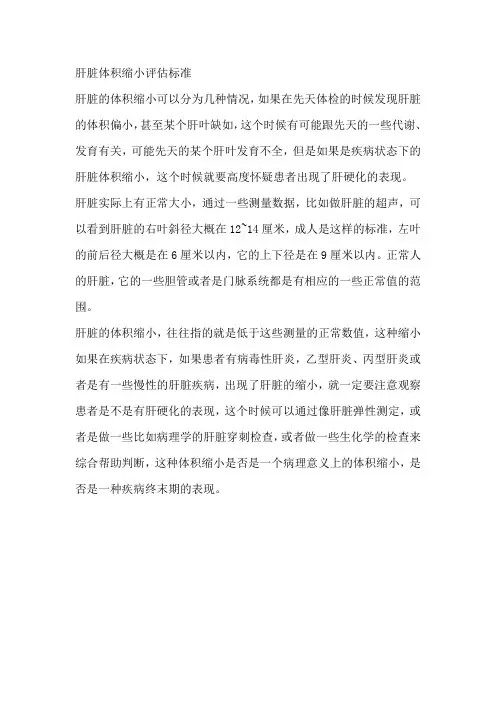
肝脏体积缩小评估标准
肝脏的体积缩小可以分为几种情况,如果在先天体检的时候发现肝脏的体积偏小,甚至某个肝叶缺如,这个时候有可能跟先天的一些代谢、发育有关,可能先天的某个肝叶发育不全,但是如果是疾病状态下的肝脏体积缩小,这个时候就要高度怀疑患者出现了肝硬化的表现。
肝脏实际上有正常大小,通过一些测量数据,比如做肝脏的超声,可以看到肝脏的右叶斜径大概在12~14厘米,成人是这样的标准,左叶的前后径大概是在6厘米以内,它的上下径是在9厘米以内。
正常人的肝脏,它的一些胆管或者是门脉系统都是有相应的一些正常值的范围。
肝脏的体积缩小,往往指的就是低于这些测量的正常数值,这种缩小如果在疾病状态下,如果患者有病毒性肝炎,乙型肝炎、丙型肝炎或者是有一些慢性的肝脏疾病,出现了肝脏的缩小,就一定要注意观察患者是不是有肝硬化的表现,这个时候可以通过像肝脏弹性测定,或者是做一些比如病理学的肝脏穿刺检查,或者做一些生化学的检查来综合帮助判断,这种体积缩小是否是一个病理意义上的体积缩小,是否是一种疾病终末期的表现。
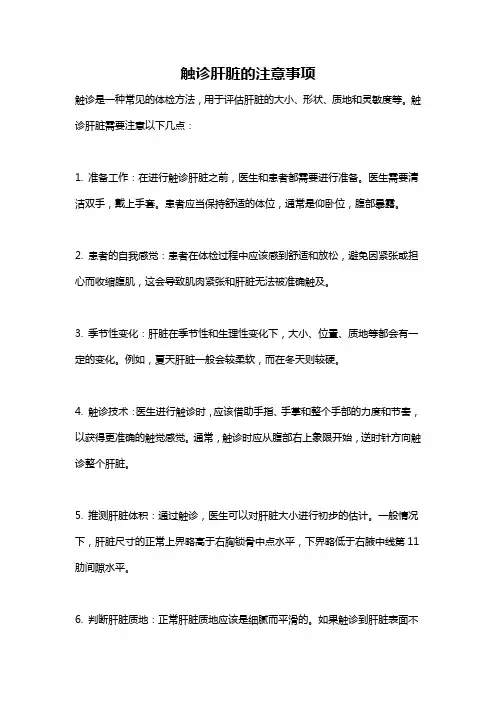
触诊肝脏的注意事项触诊是一种常见的体检方法,用于评估肝脏的大小、形状、质地和灵敏度等。
触诊肝脏需要注意以下几点:1. 准备工作:在进行触诊肝脏之前,医生和患者都需要进行准备。
医生需要清洁双手,戴上手套。
患者应当保持舒适的体位,通常是仰卧位,腹部暴露。
2. 患者的自我感觉:患者在体检过程中应该感到舒适和放松,避免因紧张或担心而收缩腹肌,这会导致肌肉紧张和肝脏无法被准确触及。
3. 季节性变化:肝脏在季节性和生理性变化下,大小、位置、质地等都会有一定的变化。
例如,夏天肝脏一般会较柔软,而在冬天则较硬。
4. 触诊技术:医生进行触诊时,应该借助手指、手掌和整个手部的力度和节奏,以获得更准确的触觉感觉。
通常,触诊时应从腹部右上象限开始,逆时针方向触诊整个肝脏。
5. 推测肝脏体积:通过触诊,医生可以对肝脏大小进行初步的估计。
一般情况下,肝脏尺寸的正常上界略高于右胸锁骨中点水平,下界略低于右腋中线第11肋间隙水平。
6. 判断肝脏质地:正常肝脏质地应该是细腻而平滑的。
如果触诊到肝脏表面不规则和颗粒感,可能是肝脏受到病变的影响,如肝硬化、肝脏结节等。
7. 判断肝脏灵敏度:触诊的目的之一是判断肝脏的灵敏度。
正常情况下,肝脏是无痛的,但当肝脏受到损害或疾病侵袭时,患者可能会感到疼痛或不适。
8. 注意特殊情况:在触诊肝脏时,还应注意特殊情况,如肝肿瘤、肝囊肿等。
这些情况下,肝脏质地和形状可能与正常情况有所不同,需要医生进行仔细触诊,以区分其性质。
9. 结合其他检查:触诊肝脏虽然是一种简单的方法,但它的敏感性和特异性相对较低。
因此,在进行触诊肝脏时,医生往往会与其他检查方法结合使用,如B 超、CT扫描、磁共振等,以获得更全面的信息。
10. 尊重患者隐私:在进行触诊肝脏时,医生应尊重患者的隐私和尊严,保持专业和谨慎的态度,与患者进行充分的沟通,并提醒患者在触诊过程中可能感到一些不适或痛感。
总结起来,触诊肝脏是一种重要的体检方法,但它只是评估肝脏状况的初步手段。
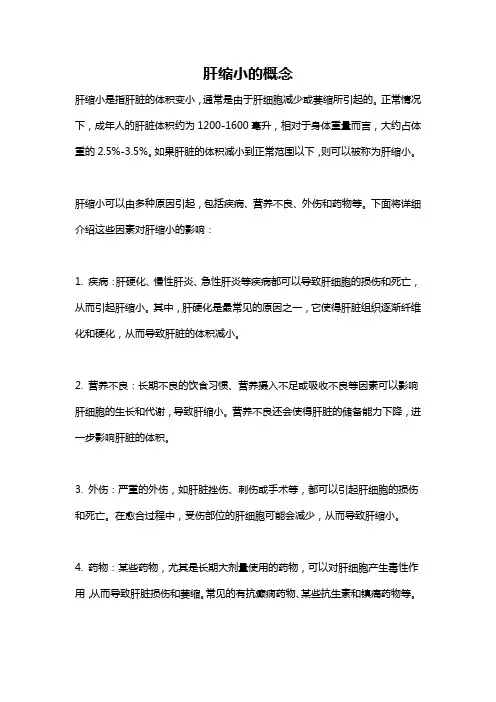
肝缩小的概念肝缩小是指肝脏的体积变小,通常是由于肝细胞减少或萎缩所引起的。
正常情况下,成年人的肝脏体积约为1200-1600毫升,相对于身体重量而言,大约占体重的2.5%-3.5%。
如果肝脏的体积减小到正常范围以下,则可以被称为肝缩小。
肝缩小可以由多种原因引起,包括疾病、营养不良、外伤和药物等。
下面将详细介绍这些因素对肝缩小的影响:1. 疾病:肝硬化、慢性肝炎、急性肝炎等疾病都可以导致肝细胞的损伤和死亡,从而引起肝缩小。
其中,肝硬化是最常见的原因之一,它使得肝脏组织逐渐纤维化和硬化,从而导致肝脏的体积减小。
2. 营养不良:长期不良的饮食习惯、营养摄入不足或吸收不良等因素可以影响肝细胞的生长和代谢,导致肝缩小。
营养不良还会使得肝脏的储备能力下降,进一步影响肝脏的体积。
3. 外伤:严重的外伤,如肝脏挫伤、刺伤或手术等,都可以引起肝细胞的损伤和死亡。
在愈合过程中,受伤部位的肝细胞可能会减少,从而导致肝缩小。
4. 药物:某些药物,尤其是长期大剂量使用的药物,可以对肝细胞产生毒性作用,从而导致肝脏损伤和萎缩。
常见的有抗癫痫药物、某些抗生素和镇痛药物等。
在临床上,肝缩小通常会伴随一些症状和体征,包括乏力、肝区疼痛、寒战、食欲不振、腹胀等。
由于肝缩小意味着肝脏的功能减弱,所以患者还可能会出现黄疸、腹水、血小板减少等临床表现。
对于肝缩小的诊断,通常需要通过临床检查和辅助检查来确定。
临床上可以通过触诊检查来初步判断肝脏的大小和质地。
而辅助检查包括血液和影像学检查。
血液检查可以评估肝功能和病因,如肝功能指标、病毒抗体和免疫球蛋白水平等。
影像学检查,如B超、CT或MRI等,可以直观地观察肝脏的形态和体积。
对于肝缩小的治疗,需要根据其具体原因进行针对性的治疗。
例如,如果是由于肝硬化引起的肝缩小,治疗的重点是改善病因因素,如治疗肝炎、酒精戒断、改善营养状况等。
对于营养不良引起的肝缩小,可以通过饮食调理和补充适当的营养物质来改善肝细胞的生长和代谢功能。
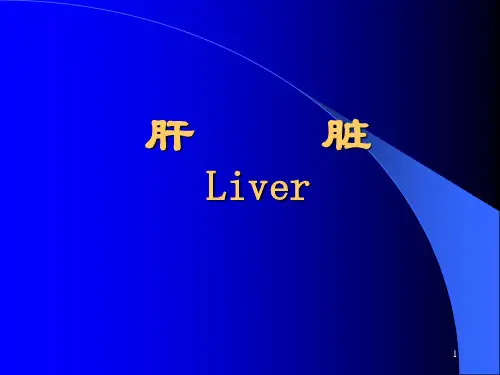
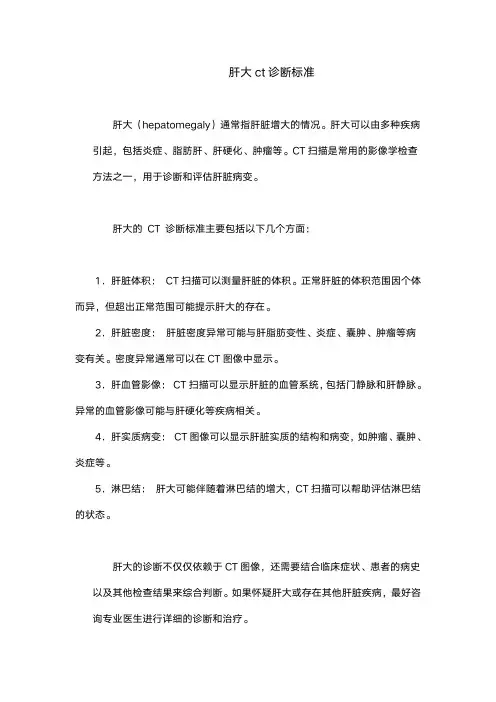
肝大ct诊断标准
肝大(hepatomegaly)通常指肝脏增大的情况。
肝大可以由多种疾病引起,包括炎症、脂肪肝、肝硬化、肿瘤等。
CT扫描是常用的影像学检查方法之一,用于诊断和评估肝脏病变。
肝大的CT诊断标准主要包括以下几个方面:
1.肝脏体积:CT扫描可以测量肝脏的体积。
正常肝脏的体积范围因个体而异,但超出正常范围可能提示肝大的存在。
2.肝脏密度:肝脏密度异常可能与肝脂肪变性、炎症、囊肿、肿瘤等病变有关。
密度异常通常可以在CT图像中显示。
3.肝血管影像:CT扫描可以显示肝脏的血管系统,包括门静脉和肝静脉。
异常的血管影像可能与肝硬化等疾病相关。
4.肝实质病变:CT图像可以显示肝脏实质的结构和病变,如肿瘤、囊肿、炎症等。
5.淋巴结:肝大可能伴随着淋巴结的增大,CT扫描可以帮助评估淋巴结的状态。
肝大的诊断不仅仅依赖于CT图像,还需要结合临床症状、患者的病史以及其他检查结果来综合判断。
如果怀疑肝大或存在其他肝脏疾病,最好咨询专业医生进行详细的诊断和治疗。
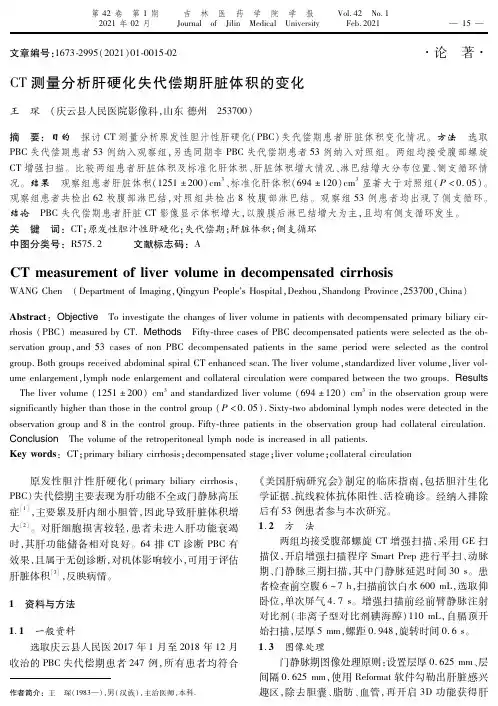
文章编号:1673 2995(2021)01 0015 02·论 著·CT测量分析肝硬化失代偿期肝脏体积的变化王 琛 (庆云县人民医院影像科,山东德州 253700)摘 要:目的 探讨CT测量分析原发性胆汁性肝硬化(PBC)失代偿期患者肝脏体积变化情况。
方法 选取PBC失代偿期患者53例纳入观察组,另选同期非PBC失代偿期患者53例纳入对照组。
两组均接受腹部螺旋CT增强扫描。
比较两组患者肝脏体积及标准化肝体积、肝脏体积增大情况、淋巴结增大分布位置、侧支循环情况。
结果 观察组患者肝脏体积(1251±200)cm3、标准化肝体积(694±120)cm3显著大于对照组(P<0.05)。
观察组患者共检出62枚腹部淋巴结,对照组共检出8枚腹部淋巴结。
观察组53例患者均出现了侧支循环。
结论 PBC失代偿期患者肝脏CT影像显示体积增大,以腹膜后淋巴结增大为主,且均有侧支循环发生。
关 键 词:CT;原发性胆汁性肝硬化;失代偿期;肝脏体积;侧支循环中图分类号:R575.2 文献标志码:ACTmeasurementoflivervolumeindecompensatedcirrhosisWANGChen (DepartmentofImaging,QingyunPeople sHospital,Dezhou,ShandongProvince,253700,China)Abstract:Objective Toinvestigatethechangesoflivervolumeinpatientswithdecompensatedprimarybiliarycir rhosis(PBC)measuredbyCT.Methods Fifty threecasesofPBCdecompensatedpatientswereselectedastheob servationgroup,and53casesofnonPBCdecompensatedpatientsinthesameperiodwereselectedasthecontrolgroup.BothgroupsreceivedabdominalspiralCTenhancedscan.Thelivervolume,standardizedlivervolume,livervol umeenlargement,lymphnodeenlargementandcollateralcirculationwerecomparedbetweenthetwogroups.Results Thelivervolume(1251±200)cm3andstandardizedlivervolume(694±120)cm3intheobservationgroupweresignificantlyhigherthanthoseinthecontrolgroup(P<0.05).Sixty twoabdominallymphnodesweredetectedintheobservationgroupand8inthecontrolgroup.Fifty threepatientsintheobservationgrouphadcollateralcirculation.Conclusion Thevolumeoftheretroperitoneallymphnodeisincreasedinallpatients.Keywords:CT;primarybiliarycirrhosis;decompensatedstage;livervolume;collateralcirculation 原发性胆汁性肝硬化(primarybiliarycirrhosis,PBC)失代偿期主要表现为肝功能不全或门静脉高压症[1],主要累及肝内细小胆管,因此导致肝脏体积增大[2]。
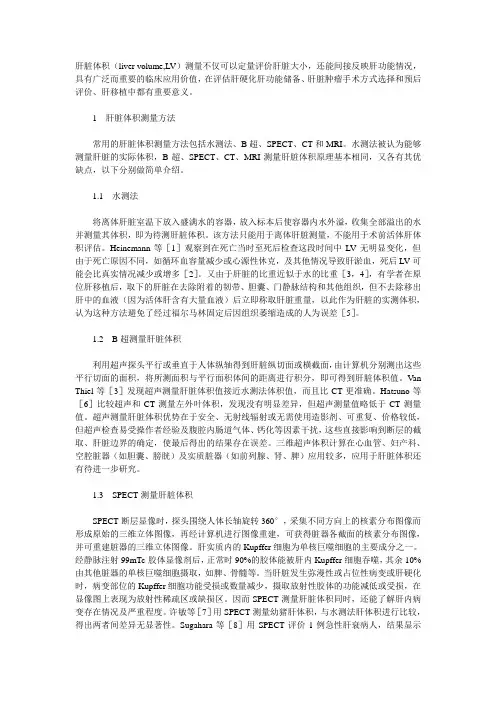
肝脏体积(liver volume,LV)测量不仅可以定量评价肝脏大小,还能间接反映肝功能情况,具有广泛而重要的临床应用价值,在评估肝硬化肝功能储备、肝脏肿瘤手术方式选择和预后评价、肝移植中都有重要意义。
1 肝脏体积测量方法常用的肝脏体积测量方法包括水测法、B超、SPECT、CT和MRI。
水测法被认为能够测量肝脏的实际体积,B超、SPECT、CT、MRI测量肝脏体积原理基本相同,又各有其优缺点,以下分别做简单介绍。
1.1 水测法将离体肝脏室温下放入盛满水的容器,放入标本后使容器内水外溢,收集全部溢出的水并测量其体积,即为待测肝脏体积。
该方法只能用于离体肝脏测量,不能用于术前活体肝体积评估。
Heinemann等[1]观察到在死亡当时至死后检查这段时间中LV无明显变化,但由于死亡原因不同,如循环血容量减少或心源性休克,及其他情况导致肝淤血,死后LV可能会比真实情况减少或增多[2]。
又由于肝脏的比重近似于水的比重[3,4],有学者在原位肝移植后,取下的肝脏在去除附着的韧带、胆囊、门静脉结构和其他组织,但不去除移出肝中的血液(因为活体肝含有大量血液)后立即称取肝脏重量,以此作为肝脏的实测体积,认为这种方法避免了经过福尔马林固定后因组织萎缩造成的人为误差[5]。
1.2 B超测量肝脏体积利用超声探头平行或垂直于人体纵轴得到肝脏纵切面或横截面,由计算机分别测出这些平行切面的面积,将所测面积与平行面积体间的距离进行积分,即可得到肝脏体积值。
V an Thiel等[3]发现超声测量肝脏体积值接近水测法体积值,而且比CT更准确。
Hatsuno等[6]比较超声和CT测量左外叶体积,发现没有明显差异,但超声测量值略低于CT测量值。
超声测量肝脏体积优势在于安全、无射线辐射或无需使用造影剂、可重复、价格较低,但超声检查易受操作者经验及腹腔内肠道气体、钙化等因素干扰,这些直接影响到断层的截取、肝脏边界的确定,使最后得出的结果存在误差。
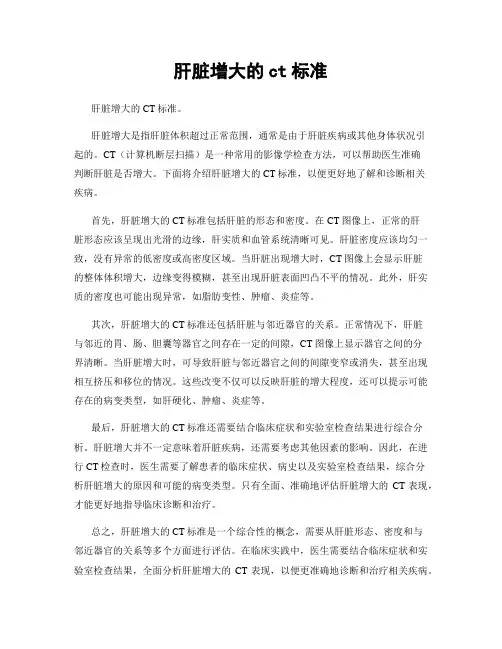
肝脏增大的ct标准肝脏增大的CT标准。
肝脏增大是指肝脏体积超过正常范围,通常是由于肝脏疾病或其他身体状况引起的。
CT(计算机断层扫描)是一种常用的影像学检查方法,可以帮助医生准确判断肝脏是否增大。
下面将介绍肝脏增大的CT标准,以便更好地了解和诊断相关疾病。
首先,肝脏增大的CT标准包括肝脏的形态和密度。
在CT图像上,正常的肝脏形态应该呈现出光滑的边缘,肝实质和血管系统清晰可见。
肝脏密度应该均匀一致,没有异常的低密度或高密度区域。
当肝脏出现增大时,CT图像上会显示肝脏的整体体积增大,边缘变得模糊,甚至出现肝脏表面凹凸不平的情况。
此外,肝实质的密度也可能出现异常,如脂肪变性、肿瘤、炎症等。
其次,肝脏增大的CT标准还包括肝脏与邻近器官的关系。
正常情况下,肝脏与邻近的胃、肠、胆囊等器官之间存在一定的间隙,CT图像上显示器官之间的分界清晰。
当肝脏增大时,可导致肝脏与邻近器官之间的间隙变窄或消失,甚至出现相互挤压和移位的情况。
这些改变不仅可以反映肝脏的增大程度,还可以提示可能存在的病变类型,如肝硬化、肿瘤、炎症等。
最后,肝脏增大的CT标准还需要结合临床症状和实验室检查结果进行综合分析。
肝脏增大并不一定意味着肝脏疾病,还需要考虑其他因素的影响。
因此,在进行CT检查时,医生需要了解患者的临床症状、病史以及实验室检查结果,综合分析肝脏增大的原因和可能的病变类型。
只有全面、准确地评估肝脏增大的CT表现,才能更好地指导临床诊断和治疗。
总之,肝脏增大的CT标准是一个综合性的概念,需要从肝脏形态、密度和与邻近器官的关系等多个方面进行评估。
在临床实践中,医生需要结合临床症状和实验室检查结果,全面分析肝脏增大的CT表现,以便更准确地诊断和治疗相关疾病。
希望本文能够帮助读者更好地理解肝脏增大的CT标准,促进临床实践的发展和进步。
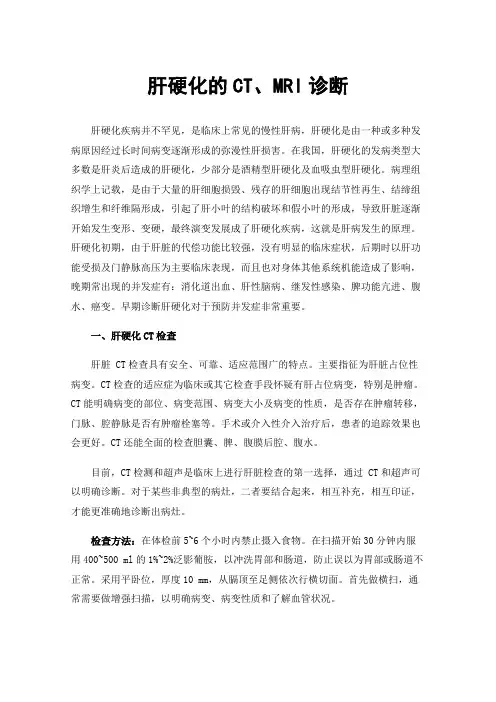
肝硬化的CT、MRI诊断肝硬化疾病并不罕见,是临床上常见的慢性肝病,肝硬化是由一种或多种发病原因经过长时间病变逐渐形成的弥漫性肝损害。
在我国,肝硬化的发病类型大多数是肝炎后造成的肝硬化,少部分是酒精型肝硬化及血吸虫型肝硬化。
病理组织学上记载,是由于大量的肝细胞损毁、残存的肝细胞出现结节性再生、结缔组织增生和纤维隔形成,引起了肝小叶的结构破坏和假小叶的形成,导致肝脏逐渐开始发生变形、变硬,最终演变发展成了肝硬化疾病,这就是肝病发生的原理。
肝硬化初期,由于肝脏的代偿功能比较强,没有明显的临床症状,后期时以肝功能受损及门静脉高压为主要临床表现,而且也对身体其他系统机能造成了影响,晚期常出现的并发症有:消化道出血、肝性脑病、继发性感染、脾功能亢进、腹水、癌变。
早期诊断肝硬化对于预防并发症非常重要。
一、肝硬化CT检查肝脏 CT检查具有安全、可靠、适应范围广的特点。
主要指征为肝脏占位性病变。
CT检查的适应症为临床或其它检查手段怀疑有肝占位病变,特别是肿瘤。
CT能明确病变的部位、病变范围、病变大小及病变的性质,是否存在肿瘤转移,门脉、腔静脉是否有肿瘤栓塞等。
手术或介入性介入治疗后,患者的追踪效果也会更好。
CT还能全面的检查胆囊、脾、腹膜后腔、腹水。
目前,CT检测和超声是临床上进行肝脏检查的第一选择,通过 CT和超声可以明确诊断。
对于某些非典型的病灶,二者要结合起来,相互补充,相互印证,才能更准确地诊断出病灶。
检查方法:在体检前5~6个小时内禁止摄入食物。
在扫描开始30分钟内服用400~500 ml的1%~2%泛影葡胺,以冲洗胃部和肠道,防止误以为胃部或肠道不正常。
采用平卧位,厚度10 mm,从膈顶至足侧依次行横切面。
首先做横扫,通常需要做增强扫描,以明确病变、病变性质和了解血管状况。
正常CT表现:CT显示肝脏有明显的实质软组织,其 CT表现为50~60 Hu,比脾、胰、肾等器官高。
肝内门脉及肝静脉以管状或圆形的低密度影象。
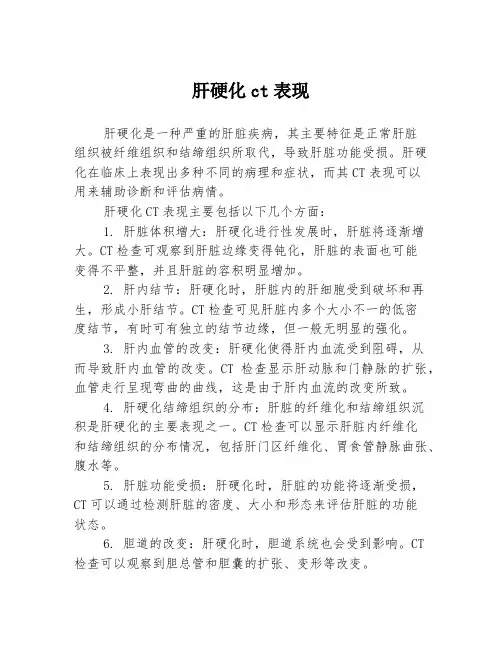
肝硬化ct表现
肝硬化是一种严重的肝脏疾病,其主要特征是正常肝脏
组织被纤维组织和结缔组织所取代,导致肝脏功能受损。
肝硬化在临床上表现出多种不同的病理和症状,而其CT表现可以
用来辅助诊断和评估病情。
肝硬化CT表现主要包括以下几个方面:
1. 肝脏体积增大:肝硬化进行性发展时,肝脏将逐渐增大。
CT检查可观察到肝脏边缘变得钝化,肝脏的表面也可能
变得不平整,并且肝脏的容积明显增加。
2. 肝内结节:肝硬化时,肝脏内的肝细胞受到破坏和再生,形成小肝结节。
CT检查可见肝脏内多个大小不一的低密
度结节,有时可有独立的结节边缘,但一般无明显的强化。
3. 肝内血管的改变:肝硬化使得肝内血流受到阻碍,从
而导致肝内血管的改变。
CT检查显示肝动脉和门静脉的扩张,血管走行呈现弯曲的曲线,这是由于肝内血流的改变所致。
4. 肝硬化结缔组织的分布:肝脏的纤维化和结缔组织沉
积是肝硬化的主要表现之一。
CT检查可以显示肝脏内纤维化
和结缔组织的分布情况,包括肝门区纤维化、胃食管静脉曲张、腹水等。
5. 肝脏功能受损:肝硬化时,肝脏的功能将逐渐受损,CT可以通过检测肝脏的密度、大小和形态来评估肝脏的功能
状态。
6. 胆道的改变:肝硬化时,胆道系统也会受到影响。
CT
检查可以观察到胆总管和胆囊的扩张、变形等改变。
总之,肝硬化的CT表现主要是肝脏体积增大,肝内结节的出现,肝内血管的改变,纤维化结缔组织的分布,肝脏功能的受损以及胆道的改变等。
肝脏CT检查在肝硬化的诊断和病情评估中具有重要的意义,但需要结合临床和其他检查结果进行综合判断。
肝脏体积(liver volume,LV)测量不仅可以定量评价肝脏大小,还能间接反映肝功能情况,具有广泛而重要的临床应用价值,在评估肝硬化肝功能储备、肝脏肿瘤手术方式选择和预后评价、肝移植中都有重要意义。
1 肝脏体积测量方法常用的肝脏体积测量方法包括水测法、B超、SPECT、CT和MRI。
水测法被认为能够测量肝脏的实际体积,B超、SPECT、CT、MRI测量肝脏体积原理基本相同,又各有其优缺点,以下分别做简单介绍。
1.1 水测法将离体肝脏室温下放入盛满水的容器,放入标本后使容器内水外溢,收集全部溢出的水并测量其体积,即为待测肝脏体积。
该方法只能用于离体肝脏测量,不能用于术前活体肝体积评估。
Heinemann等[1]观察到在死亡当时至死后检查这段时间中LV无明显变化,但由于死亡原因不同,如循环血容量减少或心源性休克,及其他情况导致肝淤血,死后LV可能会比真实情况减少或增多[2]。
又由于肝脏的比重近似于水的比重[3,4],有学者在原位肝移植后,取下的肝脏在去除附着的韧带、胆囊、门静脉结构和其他组织,但不去除移出肝中的血液(因为活体肝含有大量血液)后立即称取肝脏重量,以此作为肝脏的实测体积,认为这种方法避免了经过福尔马林固定后因组织萎缩造成的人为误差[5]。
1.2 B超测量肝脏体积利用超声探头平行或垂直于人体纵轴得到肝脏纵切面或横截面,由计算机分别测出这些平行切面的面积,将所测面积与平行面积体间的距离进行积分,即可得到肝脏体积值。
Van Thiel等[3]发现超声测量肝脏体积值接近水测法体积值,而且比CT更准确。
Hatsuno等[6]比较超声和CT测量左外叶体积,发现没有明显差异,但超声测量值略低于CT测量值。
超声测量肝脏体积优势在于安全、无射线辐射或无需使用造影剂、可重复、价格较低,但超声检查易受操作者经验及腹腔内肠道气体、钙化等因素干扰,这些直接影响到断层的截取、肝脏边界的确定,使最后得出的结果存在误差。
肝大ct诊断标准全文共四篇示例,供读者参考第一篇示例:肝大是指肝脏体积增大,常见于各种疾病的发展过程中。
肝大可由肝实质增生、脂肪性肝、肝炎、肝硬化等多种原因引起。
CT(计算机断层扫描)是一种常用的影像学检查方法,可以帮助医生诊断肝大的原因及程度。
下面将介绍一些肝大CT诊断标准。
一、肝大CT影像特征:1. 肝脏弥漫性增大:肝脏整体体积增大,形态呈圆柱体或椭圆形,边缘光滑。
肝脏密度一般均匀,偶见局部密度增高或减低。
2. 血管结构改变:肝动脉、门静脉、肝静脉等血管结构可受到压迫或扭曲,表现为血管走形,血管受压变细或扩张。
3. 肝实质病变:肝实质密度不均匀,可出现强化或减低表现。
肝叶内出现结节、囊肿、炎症等具体病变。
4. 肝包膜改变:肝包膜可能变厚或变薄,表现为包膜光整或不整。
5. 肝门静脉及胆囊周围淋巴结肿大:肝大时,门静脉周围淋巴结有时会显著增大。
二、肝大CT诊断标准:1. CT值:正常情况下,肝脏CT值在50~60HU左右。
如果肝大伴有脂肪性变化,CT值会低于正常值。
3. 血管结构变化:血管变细或扩张、血管走形等改变,有助于判断肝大的程度及可能引起肝大的病因。
4. 肝脏形态:肝脏整体体积增大,形态圆柱或椭圆形,肝包膜变化,有助于确定肝大的程度。
肝大CT诊断标准主要包括肝脏形态、密度、血管结构、包膜及门静脉、淋巴结等多方面特征。
通过详细观察CT影像,结合病史、临床表现及其他辅助检查,医生可以准确诊断肝大的原因及程度,有针对性地制定治疗方案,提高治疗效果。
希望以上信息能对您了解肝大CT 诊断标准有所帮助。
第二篇示例:肝大是指肝脏的大小超过正常范围,通常是由于疾病或其他因素引起的。
CT诊断是一种常用的影像学检查方法,可以清晰地显示肝脏的结构和大小。
在进行CT检查时,医生会根据肝脏的大小、形态和密度等特征来判断是否存在肝大的情况。
下面我们将介绍一下肝大CT诊断的标准。
1. 肝脏大小的测量在进行CT检查时,医生会测量肝脏的长度、宽度和厚度,从而得出肝脏的体积。
国人正常肝脏体积计算公式的研究及意义
肝脏是人体中最大的脏器之一,其大小和体积与人的年龄、性别、身高、体重、肥胖程度、肝病状态等有关。
因此,了解人体中肝脏的
正常大小和体积的计算公式对于医疗诊断和治疗非常重要。
目前常用的计算肝脏体积的公式有两种:线性方法和体积法。
线
性方法是根据肝脏的长、宽、高来计算其体积,常用公式为:肝脏体
积(ml)=0.681×长(cm)×宽(cm)×高(cm)+8.785。
而体积法
是利用影像学技术(如CT、MRI等)测量肝脏的体积,并根据体积公
式计算。
体积法因其精度高,应用范围广而在临床上更为常用。
了解人体中肝脏的正常体积可以帮助医生判断肝脏是否偏大或偏小,对于肝脏疾病的诊断和治疗也有很大的帮助。
例如,对于肝硬化、肝癌等疾病,肝脏的大小与体积的变化可以作为诊断标准之一,也可
以通过检测肝脏体积的变化来判断治疗的有效性。
总之,计算人体中肝脏的正常大小和体积,对于肝脏疾病的诊断
和治疗具有重要的意义。
肝大测量超声诊断标准全文共四篇示例,供读者参考第一篇示例:肝大是指肝脏增大或肝脏尺寸超过正常范围,这可能是由于慢性肝病、脂肪肝、酗酒、感染等各种原因引起的。
肝大的检测通常通过超声检查来进行,而超声检查是一种无创侵入,安全可靠的检查方法,因此被广泛用于肝大的诊断和监测。
肝大的确诊需要依靠专业医生进行超声检查,通过超声图像来诊断。
但是在临床实践中,对于肝大的判断有时因为医生的主观因素或操作不当而存在一定的误差。
因此,在制定肝大测量超声诊断标准时,需要考虑到各种可能的情况,避免误判,提高诊断准确性。
肝大的测量需要测量肝脏的长度、宽度和厚度等多个指标,通过多个参数的综合评估来判断肝脏是否健康以及有无异常情况。
在进行超声检查时,医生需要仔细观察肝脏的形态和组织结构,排除任何可能的异常情况。
同时,医生还需要关注患者的临床症状以及其他检查结果,综合判断出肝大的原因和病情进展。
在制定肝大测量超声诊断标准时,需要考虑到不同人群的生理特征和疾病情况。
例如,儿童和成人的肝脏大小会有所不同,因此需要制定不同的测量标准。
同时,对于患有肝病或其他疾病的患者,肝脏的形态和结构可能会有一定的变化,因此需要特别注意诊断的准确性。
另外,肝大的测量还需要考虑到超声仪器的性能和操作流程。
医生需要使用高质量的超声仪器,并按照正确的操作规程进行检查,以确保测量结果的准确性和可靠性。
同时,医生还需要不断提高自身技术水平,不断学习和实践,以提高对肝大的诊断能力。
除了超声检查外,还可以结合其他影像学检查和实验室检查来进行对比,以提高诊断的准确性。
例如,可以结合CT、MRI等影像学检查,或者检查血液、尿液等实验室指标,来辅助判断肝脏的病变情况。
这些检查方法的结合可以提高对肝大的诊断准确性,避免漏诊或误诊。
总之,肝大的测量超声诊断标准是医生进行肝脏检查和诊断的重要指南,制定合理的标准可以提高肝大的诊断准确性,帮助医生及时发现问题、做出正确的诊断和治疗方案。
肝脏体积变化的判断
(1).无论肝脏肿大还是缩小,均以肝脏高度变化为主。
(2).肝门至膈顶高<6.0cm,肝门至膈顶高
/肝右叶厚<0.65,即可认为肝脏
体积缩小。
肝门至膈顶高度为5~6cm者,肝脏轻度缩小;4~5cm者,肝脏中度缩小;4cm以下者,重度缩小。
(3).肝门至膈顶高>9.5cm,其与右叶厚度比>0.85,可以考虑肝脏肿大,肝门至膈顶高度9.5~10.5cm为轻度肿大;10.5~11.5cm为中度肿大;11.5cm以上为重度肿大。
(4).一些身材矮小、体重轻的个体,往往肝脏体积小于平均值,只要肝门至膈顶高/肝右叶厚度在0.65~0.85,就不能认为肝体积
缩小,只能考虑个体差异。
而在肝大的部分患者中,如果这一比值保持在0.85以内,肝脏形态往往保持正常,脂肪肝人群多属这种情况。